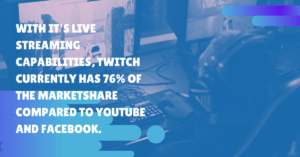Less detailed metrics might be a good way to measure growth numbers such as downloads, page views, registered users and tweets to see if your campaign is gaining traction.
However, it is important to distinguish between real metrics and vanity metrics. Vanity metrics can be misinterpreted or even manipulated so it is necessary to correlate more factual numbers: active users, engagement, the cost of getting new customers, and ultimately revenues and profits.
Influencer Marketing Reporting 1.0: Follower Count
Most companies get positive results from influencer marketing but some businesses fail to choose influencers who have followers similar to the people who make up the target market for the brand’s product. It is imperative when choosing an influencer to choose quality over quantity. When influencer marketing first started, companies measured the success of influencer marketing through the number of followers an influencer had. The more followers, the more reach a brand could potentially have with new audiences.
However, as social media evolved, algorithms changed, and it meant that even if an influencer had a ton of followers – it didn’t mean those followers saw, engaged with, or made a purchase decision from a company’s influencer marketing efforts.
As the landscape evolved, the way we measure influencers evolved.
Influencer Marketing Reporting 2.0: Likes and Comments
Companies started to measure influencer marketing by engagement factors on influencer posts (i.e. likes, commenting, actively sharing, etc.) This was a great way to see what resonated with a target audience and what did not.
However, it is hard to draw a direct conclusion around the bottom line through measuring likes and comments alone. These measurements show user affinity, but not a direct impact on brand revenue. Plus, with platforms like Instagram moving toward a model of hiding likes, brands need a more concrete way to measure their influencer marketing campaigns.
Influencer Marketing Reporting 3.0: ROI on Campaigns
The next level of influencer marketing measurement is all about tying your marketing efforts to your company’s bottom line. It shows how many people actually converted from an influencer marketing post. A great way to do this is to share unique promo codes, discounts or exclusive offers through influencer’s content. By providing a unique promo code or custom URL, you can track the performance of each influencer.
There are also performance-based affiliate marketing campaigns which are mutually beneficial arrangements where an influencer earns revenue on their influence. The three most popular are pay-per-click, pay-per-sale and pay-per-lead. Pay-per-sale pays the influencer a percentage of all purchases. The pay-per-click model is traffic via the affiliate link and pay-per-lead occurs when the influencer receives revenue after consumers become a new lead as a result of the affiliate partnership.
Tools like Sideqik can help draw the direct connection between your influencer marketing campaigns and the ROI they bring your company. Sideqik’s influencer marketing analytics empower brands to discover new influencers, manage the relationships with influencers they already have, and measure the results of carefully crafted campaigns. The platform works with brands in every step of social media engagement, starting with engaging with fans and ending with the measurement of sales and results
ROI is Crucial to Influencer Marketing
Whether your goal is to increase awareness in a new market or drive purchases to get a direct response, the ROI helps justify the budget and resources allocated to your influencer marketing campaigns. Most of today’s influencer marketing reporting is missing direct ROI measurement to the bottom line.
Sideqik is a resourceful tool to help easily find influencers of any size from our database of over 16 million profiles across more than 10 of the world’s largest social networks. Our robust audience analytics breakdown the ages, gender, race, and even income to ensure your influencer’s audience aligns with your target demographic. We are your beginning to end influencer marketing solution.
Nancy Rothman
Latest posts by Nancy Rothman (see all)
- How Travel Brands Can Use Influencer Marketing to Stay Afloat as the Pandemic Continues - February 22, 2022
- Influencer Marketing Trends to Watch (And Prepare For) in 2022 - December 31, 2021
- A Guide: How to Recruit the Right Influencers for Your Brand - December 30, 2021







